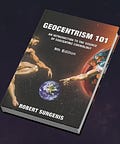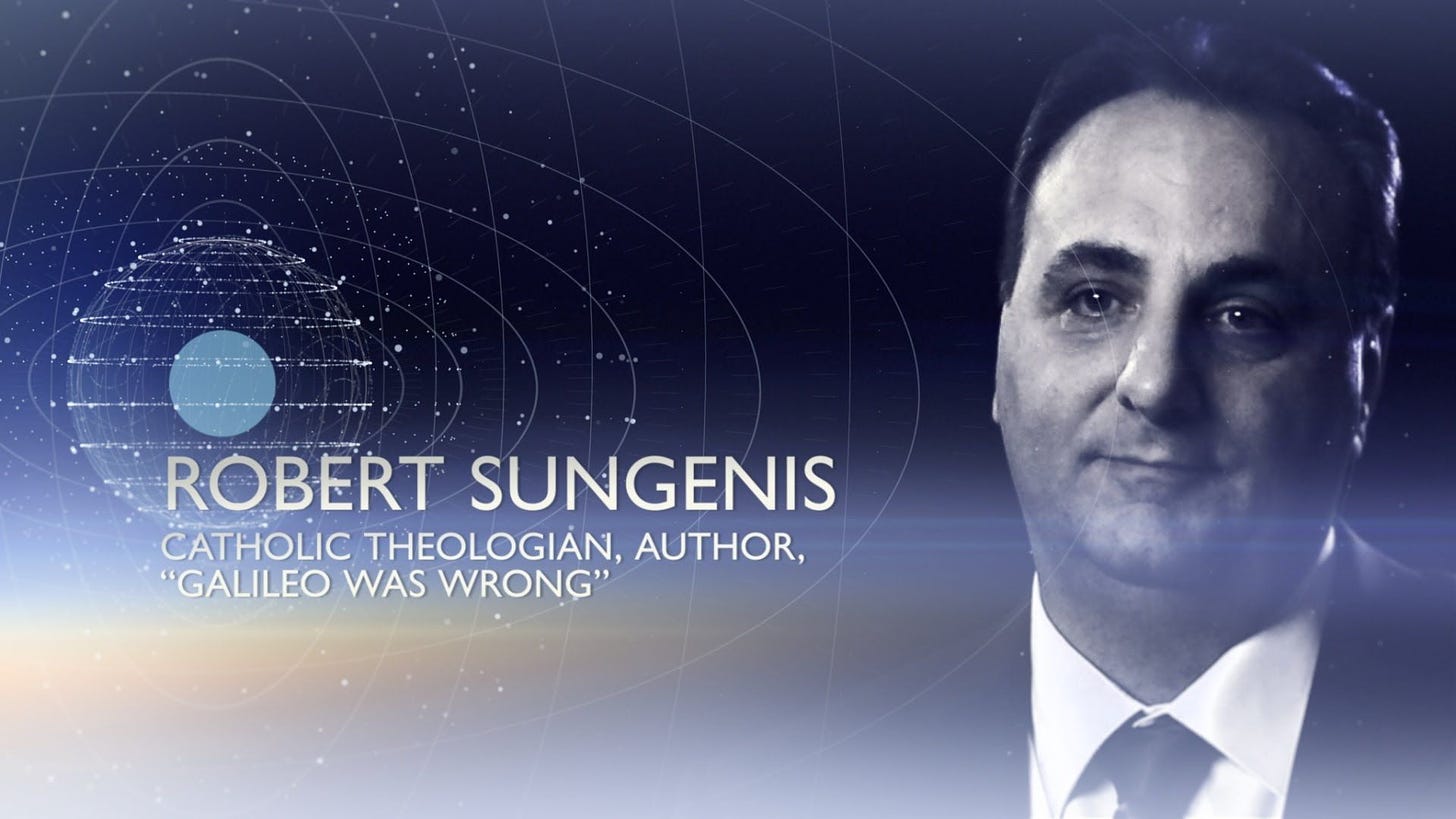A response to Mr. Caoimhín P. Connell from Dr. Robert Sungenis with Catholic Apologetics International...
Clip from the beginning of a brand new paper giving answers to some of the tough questions thrown at Dr. Robert Sungenis and The Church's, Geocentric, Traditional Catholic Doctrine of Creation...
A response to Mr. Caoimhín P. Connell from Dr. Robert Sungenis with Catholic Apologetics International...
C. Connell: When I speak of bad arguments, it's based on statements like those found on your web site where you make a declarative statement about the "dilemma " of the Church and pose the rhetorical question of how could She have "blundered." But I don't see the dilemma, and I don't see a conflict between reality and the teachings of the Church, and like the Church, I don't see an inconsistency or contradiction between an heliocentric (or barycentric) model and the traditional teachings and development of doctrine in the Church.
R. Sungenis: That’s why you don’t see the dilemma. You think the heliocentric system is the true system, so naturally you’re going to think there was no “dilemma.” If your first premise is wrong (that the Earth moves), then your second premise is wrong (that the Church condoned a moving Earth).
That the Church condemned a moving earth can easily be demonstrated from the historical records.
In its 1616 decrees, this is what the Church said, all approved by Paul V:
lDecree of the Sacred Congregation of the most Illustrious Cardinals of the Holy Roman Church specially delegated by Our Most Holy Lord Pope Paul V and the Holy Apostolic See to publish everywhere throughout the whole of Christendom.1 And whereas it has also come to the knowledge of the said Congregation that the Pythagorean doctrine – which is false and altogether opposed to Holy Scripture – of the motion of the Earth and the immobility of the Sun, which is also taught by Nicolaus Copernicus in De revolutionibus orbium coelestium, and by Diego de Zúñiga [in his book] on Job, is now being spread abroad and accepted by many – as may be seen from a certain letter of a Carmelite Father, entitled Letter of the Rev. Father Paolo Antonio Foscarini, Carmelite, on the Opinion of the Pythagoreans and of Copernicus concerning the Motion of the Earth, and the Stability of the Sun, and the New Pythagorean System of the World, at Naples, Printed by Lazzaro Scorriggio, 1615; wherein the said Father attempts to show that the aforesaid doctrine of the immobility of the Sun in the center of the world, and of the Earth’s motion, is consonant with truth and is not opposed to Holy Scripture. Therefore, in order that this opinion may not insinuate itself any further to the prejudice of the Catholic truth, the Holy Congregation has decreed that the said Nicolaus Copernicus, De revolutionibus orbium, and Diego de Zúñiga, On Job, be suspended until they be corrected; but that the book of the Carmelite Father, Paolo Antonio Foscarini, be altogether prohibited and condemned, and that all other works likewise, in which the same is taught, be prohibited, as by this present decree, it prohibits, condemns, and suspends them all respectively.2 We, Robert Cardinal Bellarmine, have heard that Signor Galileo Galilei is being calumniated or alleged to have abjured in our hands and also to have been given salutary penances for this. Having been sought about the truth of the matter, we say that the above-mentioned Galileo has not abjured in our hands, or in the hands of others, here in Rome, or anywhere else that we know, any opinion or doctrine of his; nor has he received any penances, salutary or otherwise. He has only been notified of the declaration made by the Holy Father and published by the Sacred Congregation of the Index, whose content is that the doctrine attributed to Copernicus (that the earth moves around the sun and the sun stands at the center of the world without moving from the east to the west) is contrary to Holy Scripture, and therefore cannot be defended nor held. In witness whereof we have written and signed this with our own hands, on the 26th day of May 1616.3 Friday, the 26th of the same month [February 1616], at the palace, the usual residence of the said Most Illustrious Lord Cardinal Bellarmine, and in the chambers of His Most Illustrious Lordship, and in the presence of the Reverend Father Michelangelo Segizzi of Lodi, O. P., Commissary of the Holy Office, having summoned the above-mentioned Galileo before himself, the same Most Illustrious Lord Cardinal warned Galileo that the above-mentioned opinion was erroneous and that he should abandon it; and thereafter, indeed immediately, before me and witnesses, the Most Illustrious Lord Cardinal himself being also present still, the aforesaid Father Commissary, in the name of His Holiness the Pope and the whole Congregation of the Holy Office, ordered and enjoined the said Galileo, who was himself still present, to abandon completely the above-mentioned opinion that the sun stands still at the center of the world and the earth moves, and henceforth not to hold, teach, or defend it in any way whatever, either orally or in writing; otherwise the Holy Office would start proceedings against him. The same Galileo acquiesced in the injunction and promised to obey.4 In the month of February 1616, Lord Cardinal Bellarmine told me that since Copernicus’ opinion, taken absolutely, was contrary to Holy Scripture, it could be neither held nor defended, but it could be taken and used ex suppositione (suppositionally). In conformity with this I keep a certificate by Lord Cardinal Bellarmine himself, dated 26 May 1616, in which he says that Copernicus’ opinion cannot be held or defended, being against Holy Scripture. I present a copy of this certificate, and here it is.5 Sentence: Whereas you, Galileo, son of the late Vincenzo Galilei, Florentine, age seventy years, were in the year 1615 denounced to this Holy Office for holding as true the false doctrine taught by some that the sun is the center of the world and immovable and that the Earth moves, and also with diurnal motion;6 for having disciples to whom you taught the same doctrine; for holding correspondence with certain mathematicians of Germany concerning the same; for having printed certain letters, entitled “On the Sunspots,” wherein you developed the same doctrine as true; and for replying to the objections from the Holy Scriptures, which from time to time were urged against it, by glossing the said Scriptures according to your own meaning:7 and whereas there was thereupon produced the copy of a document in the form of a letter, purporting to be written by you to one formerly your disciple, and in this divers propositions are set forth, following the position of Copernicus, which are contrary to the true sense and authority of Holy Scripture:8
1 “Decretum Sacrae Congregationis Illustrissimorum S.R.E.Cardinalium, a S.D.N. Paulo Papa V Sanctaque Sede Apostolica ad Indicem librorum, eorumdemque permissionem, proibitionem, expurgationem et impressionem in universa Republica Christiana, specialieter deputatorum, ubique publicandum” (Antonio Favaro, Galileo E L’Inquisizione, p. 63; Le Opere di Galileo Galilei, vol. 19, p. 323).
2 Original Latin: “….Et quia etiam ad notitiam praefatae Sacrae Congregationis pervenit, falsam illam doctrinam Pithagoricam, divinaeque Scripturae omnino adversantem, de mobilitate terrae et immobilitate solis, quam Nicolaus Copernicus De revolutionibus orbium coelestium, et Didacus Astunica in Job, etiam docent, iam divulgari et a multis recipe; sicuti videre est ex quadam Epistola impressa cuiusdam Patris Carmelitae, cui titulus: « Lettera del R. Padre Maestro Paolo Antonio Foscarini Carmelitano, sopra l’opinione de’Pittagorici e del Copernico della mobilità della terra e stabilità del sole, et il nuovo Pittagorico sistema del mondo. In Napoli, per Lazzaro Scoriggio, 1615 », in qua dictus Pater ostendere conatur, praefatam doctrinam de immobilitate solis in centro mundi et mobilitate terrae consonam esse veritati et non adversary Sacrae Scripturae; ideo, ne ulterius huiusmodi Opinio in perniciem Catholicae veritatis serpat, censuit, dictos Nicolaum Copernicum De revolutionibus orbium, et Didacum Astunica in Job, suspendendos esse, donec corrigantur; librum vero Patris Pauli Antonii Foscarini Carmelitae omnino prohibendum atque damnandum; aliosque omnes libros, partier idem docentes, prohibendos: prout praesenti Decreto omnes respective prohibit, damnat atque suspendit. In quorum fidem praesens Decretum manu et sigillo Illustrissimi et Reverendissimi D. Cardinalis S. Caeciliae, Episcopi Albanensis, signatum et munitum fuit, die 5 Martii 1616.” Part of above translation taken from de Santillana’s The Crime of Galileo, as cited by Fantoli in Galileo: For Copernicanism and For the Church, pp. 223-224.
3 Original Italian: “Noi Roberto Bellarmino, havendo inteso che il Sig. Galileo Galilei sia calunniato o imputato di havere abiurato in mano nostra, et anco di essere stato per ciò penitenziato di penitenzie salutary, et essendo ricercati della verità, diciamo che il suddetto S. Galileo non ha abiurato in mano nostra nè di altri qua in Roma, nè meno in altro luogo che noi sappiamo, alcuna sua opinione o dottrina, nè manco ha ricevuto penitenzie salutary nè d’altra sorte, ma solo gl’ è stata denuntiata la dichiaratione fatta da Nostro Signore et publicata dalla Sacra Congregatione dell’ Indice, nella quale si contiene che la dottrina attribuita al Copernico, che la terra si muova intorno al sole et che il sole stia nel centro del mondo senza muoversi da oriente ad occidente, sia contraria alle Sacre Scritture, et però non si possa difendere nè tenere. Et in fede di ciò habbiamo scritta e sottoscritta la presente di nostra propria mano, questo dì 26 di Maggio 1616. Il med. Di sopra Robert Card. Bellarmino” (Antonio Favaro, Galileo e l’Inquisizione, pp. 82, 88).
4 Le Opere di Galileo Galilei, Antonio Favaro, vol. 19, pp. 321-322, translated by Annibale Fantoli in The Church and Galileo, pp. 119-120; the same version in Maurice Finocchiaro’s The Galileo Affair, p. 147. An injunction is a formal order from a court of law or canonical court ordering a person or group to do or not do something.
5 Le Opere di Galileo Galilei, Antonio Favaro, vol. 19, p. 339, translated by Annibale Fantoli in The Church and Galileo, p. 127.
Fantoli adds: “The Latin expression ex suppositione had a different meaning for Bellarmine than it did for Galileo. For the cardinal it meant that the Copernican theory could be used as a purely mathematical hypothesis for astronomical calculations and thus for ‘saving the phenomena.’ For Galileo, it meant that the Copernican theory could be used as a physical hypothesis, which might later on be shown to represent the real constitution of the world. Galileo relied on the latent ambiguity of this expression to justify the writing of the Dialogue” (ibid., p. 146).
6 “falsa dottrina, da alcuni insegnata, ch’il sole sia centro del mondo et imobile, e che la terra si muova anco di moto diurno” (Galileo E L’Inquizisione, Favaro, p. 143).
7 “rispondevi glosando detta Scrittura conforme al tuo senso” (ibid). 8 “si contengono varie propositioni contro il vero senso et auttorità della Sacra Scrittura” (ibid).
C. Connell: Similarly, the statement "Einstein’s Special Relativity: Invented to Keep the Earth Moving" for which I know of no support for such a conclusion.
R. Sungenis: You would know it if you knew the history of the science. You should read at least Geocentrism 101 to educate yourself to what you obviously don’t know. It will tell you all about the experiments in the 1800s that showed the earth wasn’t moving in space (e.g., Arago, Airy, Michelson, Michelson-Morley, Morley-Miller) and that Einstein himself admitted in his 1920 Kyoto speech that he invented Special Relativity to answer these experiments so that, at least on paper, he could keep the earth moving. What you have probably heard is that Einstein believed the experiments were showing the non existence of ether when, in fact, the corollary of that presupposition is that the Earth isn’t moving through the ether. Many scientists have admitted this fact. In the late 1950s, historian Bernard Jaffe stated in his book Michelson and the Speed of Light:
The data were almost unbelievable… There was only one other possible conclusion to draw — that the Earth was at rest.9
In the late 1960s, historian Adolf Baker in his book Modern Physics and Antiphysics, stated:
….Thus, failure [of Michelson-Morley] to observe different speeds of light at different times of the year suggested that the Earth must be ‘at rest’…It was therefore the ‘preferred’ frame for measuring absolute motion in space.10
In 1954, theoretical physicist James Coleman wrote in his book Relativity for the Layman, the following admission:
….The easiest explanation was that the earth was fixed in the ether and that everything else in the universe moved with respect to the earth and the ether….Such an idea was not considered seriously, since it would mean in effect that our earth occupied the omnipotent position in the universe, with all the other heavenly bodies paying homage by moving around it.11
In a book that Albert Einstein himself endorsed by writing the Foreword, he says the following: Barnett writes:
“The Michelson-Morley experiment confronted scientists with an embarrassing alternative.
On the one hand they could scrap the ether theory which had explained so many things about electricity, magnetism, and light. Or if they insisted on retaining the ether they had to abandon the still more venerable Copernican theory that the earth is in motion. To many physicists it seemed almost easier to believe that the earth stood still than that waves – light waves, electromagnetic waves – could exist without a medium to sustain them. It was a serious dilemma and one that split scientific thought for a quarter century. Many new hypotheses were advanced and rejected. The experiment was tried again by Morley and by others, with the same conclusion; the apparent velocity of the earth through the ether was zero”.
The Great Courses, published in 2000, repeats the same information. In Lecture 6 of the DVD, quoting Professor Richard Wolfson, it states:
What happened when the experiment was done in 1887? There was never, never, in any orientation at any time of year, any shift in the interference pattern; none; no shift; no fringe shift; nothing. What’s the implication? Here was an experiment that was done to measure the speed of the earth’s motion through the ether. This was an experiment that was ten times more sensitive than it needed to be. It could have detected speeds as low as two miles a second instead of the known 20mps that the earth as in its orbital motion around the sun. It didn’t detect it. What’s the conclusion from the Michelson-Morley experiment?
The implication is that the earth is not moving… There are dozens more of these kinds of admissions by scientists of that day.
4 Le Opere di Galileo Galilei, Antonio Favaro, vol. 19, pp. 321-322, translated by Annibale Fantoli in The Church and Galileo, pp. 119-120; the same version in Maurice Finocchiaro’s The Galileo Affair, p. 147. An injunction is a formal order from a court of law or canonical court ordering a person or group to do or not do something.
5 Le Opere di Galileo Galilei, Antonio Favaro, vol. 19, p. 339, translated by Annibale Fantoli in The Church and Galileo, p. 127.
Fantoli adds: “The Latin expression ex suppositione had a different meaning for Bellarmine than it did for Galileo. For the cardinal it meant that the Copernican theory could be used as a purely mathematical hypothesis for astronomical calculations and thus for ‘saving the phenomena.’ For Galileo, it meant that the Copernican theory could be used as a physical hypothesis, which might later on be shown to represent the real constitution of the world. Galileo relied on the latent ambiguity of this expression to justify the writing of the Dialogue” (ibid., p. 146).
6 “falsa dottrina, da alcuni insegnata, ch’il sole sia centro del mondo et imobile, e che la terra si muova anco di moto diurno” (Galileo E L’Inquizisione, Favaro, p. 143).
7 “rispondevi glosando detta Scrittura conforme al tuo senso” (ibid). 8 “si contengono varie propositioni contro il vero senso et auttorità della Sacra Scrittura” (ibid).
Bernard Jaffe, Michelson and the Speed of Light, 1960, p. 76.
10 Adolf Baker, Modern Physics & Antiphysics, p. 54, 1970.
11 James A. Coleman, Relativity for the Layman, p. 37. Of Coleman’s book Einstein wrote: “Gives a really clear idea of relativity” (front cover of the 1954 edition).
… to be continued.





